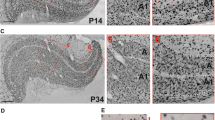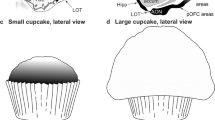Summary
The individual prenatal ontogenetic history of the horizontal neurons (the Cajal-Retzius cells) of layer I, the Martinotti neurons of layer VI, the pyramid-like neurons (the polymorphous or spindle cells) of layer VI, and the pyramidal neurons of layer V of the cat neocortex have been investigated. These neurons undergo, in the course of prenatal ontogenesis, a series of significant changes in their dendritic and axonic arborizations resulting in their complete structural transformation. Some of these changes have led to the appearance of new types of neurons quite different from the original in their morphological features as wells as in the territory of distribution of their axons. The horizontal neurons of layer I (superficial plexiform layer) come to assume the morphological characteristics of Cajal-Retzius cells late in prenatal ontogenesis. Also, the pyramid-like neurons of layer VI (deep plexiform layer) acquire the features of polymorphous (spindle) neurons of layer VI late in prenatal neocortical ontogenesis.
Certainly, the resulting functional transformations that these neuronal changes cause are important and of great significance in the understanding of the organization of the mammalian neocortex. In the course of prenatal ontogenesis the following occur: the horizontal neurons of layer I lose their axonic connections with layer VI and acquire an increasing relevance in the structural organization of layer I; the pyramid-like neurons of layer VI lose their axonic and dendritic connections with layer I and undergo pronounced regressive changes in their dendritic and axonic arborizations; and the Martinotti neurons lose their axonic connections with layer I and also undergo regressive changes in their dendritic arborizations. In addition, the structural-functional interrelationships among these three neurons, which are quite prominent during early neocortical ontogenesis, fade away in the course of late prenatal ontogenesis and possibly disappear altogether by the time of birth in the cat. These three neurons are the basic neuronal elements of the early, precallosal organization (the primordial neocortical organization) of the mammalian neocortex. Phylogenetically, these three types of neurons are very old ones and have been described in the cerebral cortices of amphibians and reptiles. Therefore, it is not surprising that the early, precallosal organization of the mammalian neocortex should resemble the structural organization of the reptilian (general cortex) neocortex.
It is postulated in this communication that these neuronal transformations are the result of a restructuring in the organization of the mammalian neocortex which follows the arrival of the callosal fibers and of a new type of corticipetal fibers at the pyramidal plate. this restructuring represents a transformation of the fibrillary-neuronal structure of the mammalian neocortex from its early, precallosal (reptilian) organization into a more distinctly mammalian one. The mammalian neocortical organization is characterized by the sequential maturation of several strata of true pyramidal neuronal systems. In the course of prenatal ontogenesis the fibrillar and neuronal elements of the early, precallosal neocortical organization lose progressively their relevance in the structural organization of the mammalian neocortex while the new pyramidal neuronal systems acquire an increasing relevance in it.
Similar content being viewed by others
References
Angevine, J. B.: Critical cellular events in the shaping of neural centers: In: The neurosciences (ed. F. O. Schmitt), p. 62–73. New York: The Rockefeller University Press 1970.
Angevine, J. B., Sidman, R. L.: Autoradiographic study of cell migration during histogenesis of cerebral cortex of the mouse. Nature (Lond.) 192, 766–768 (1961).
Aström, K.-E.: On the early development of the isocortex in fetal sheep. In: Progress in brain research, vol. 26, Developmental neurology (eds. C. G. Bernhard and J. P. Schadé), p. 1–59. Amsterdam: Elsevier Publ. 1967.
Ariën Kappers, C. U., Huber, G. C., Crosby, E. C.: The comparative anatomy of the nervous system of vertebrates inculding man, vol. II, p. 1348, 1401, 1409. New York: Macmillan comp. 1936.
Cajal, S. R.: Histologie du système nerveux de l'homme et des vertébres, vol. II, p. 836–846. Paris Maloine 1911. Reprinted: Madrid: Consejo Superior de Investigaciones Cientificas 1952.
Cajal, S. R.: Ètudes sur la neurogenese de quelques vertébres. Madrid: 1929.
Cajal, P. R.: El cerebro de los batracios. In: Libro en Honor de D. S. Ramón y Cajal, vol. I, p. 13–59. Madrid: Jimenez Molina Publ. 1922.
Lorente de Nó, R.: Studies on the structure of the cerebral cortex. I. Area entorhinalis. J. Psychol. Neurol. (Lpz.) 45, 381–438 (1933).
Marin-Padilla, M.: Prenatal and early postnatal ontogenesis of the human motor cortex. I. The sequential development of the cortical layers. Brain Res. 23, 167–183 (1970).
Marin-Padilla, M.: Early prenatal ontogenesis of the cerebral cortex (neocortex) of the cat (Felis Domestica). A Golgi study. I. The primordial neocortical organization. Z. Anat. Entwickl.-Gesch. 134, 117–145 (1971).
Morest, D. K.: The growth of synaptic ending in the mammalian brain: A study of the calices of the trapezoid body. Z. Anat. Entwickl.-Gesch. 127, 201–220 (1968).
Morest, D. K.: A study of neurogenesis in the forebrain of opossum pouch young. Z. Anat. Entwickl.-Gesch. 130, 265–305 (1970).
Sidman, R. L.: Cell proliferation, migration, and interaction in the developing mammalian central nervous system. In: The neurosciences. (ed. F. O. Schmitt), p. 100–108. New York: The Rockefeller University Press 1970.
Stensaas, L. J.: The development of hippocampal and dorsolateral pallial regions of the cerebral hemispheres in fetal rabbits. III. twenty-nine millimeter stage, Marginal lamina. J. comp. Neurol. 130, 149–162 (1967).
Stensaas, L. J.: The development of hippocampal and dorsolateral pallial regions of the cerebral hemispheres in fetal rabbits. IV. Forty-one millimeter stage, Intermediate lamina. J. comp. Neurol. 130, 409–422 (1967).
Stensaas, L. J.: The development of hippocampal and dorsolateral pallial regions of the cerebral hemispheres in fetal rabbits. VI. Ninety millimeter stage, cortical differentiation. J. comp. Neurol. 132, 93–108 (1968).
Author information
Authors and Affiliations
Additional information
Supported by Grant HD-03298 and by General Research Support Grant FR-05392 from the General Research Branch, National Institutes of Health.
Rights and permissions
About this article
Cite this article
Marin-Padilla, M. Prenatal ontogenetic history of the principal neurons of the neocortex of the cat (Felis domestica) a golgi study. Z. Anat. Entwickl. Gesch. 136, 125–142 (1972). https://doi.org/10.1007/BF00519174
Received:
Issue Date:
DOI: https://doi.org/10.1007/BF00519174




